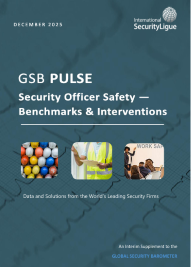
Evolving international issues are impacting the security of supply lines, requiring organizations to integrate security throughout supply chain activities to meet the shifting threat environment. What emerging security issues now threaten the supply chain? Which solutions yield business value beyond protection? This article examines how to address today’s critical security issues to forge a more predictable supply chain, gain efficiencies, and score competitive advantage—as well as to maximize preparedness for managing security-related disruptions.
Key Points
- Cargo theft is growing in scale and complexity and has become a greater concern of company executives and security leaders alike—but most corporate CEOs perceive relatively poor alignment between security and supply chain management.
- Investing in supply chain security reduces losses from theft, and research proves there is also significant collateral value, from reducing excess inventory, increasing on-time deliveries, to reducing cargo delays and transit time.
- Successful risk reduction requires upgrading and enhancing security, cooperation and communication among supply chain stakeholders, and a quick response to evolving theft trends, which today include organized crime infiltration at ports and distribution hubs, partial load theft, “theft to order,” and carrier collusion.
The importance of supply chain security and extracting maximum value
More than 1-in-5 Chief Security Officers globally expect to experience a supply chain attack this year, more than experienced events last year, according to The World Security Report by Allied Universal/G4S and derived from a survey of 1,775 CSOs from 30 countries. In addition to experiencing an additional number of attacks, global security leaders are likely to see a shift in the form of those attacks, as threats to assets in transit are evolving in response to existing security measures and the shifting nature of the supply chain. (These emerging issues are discussed in the next section.)
Successfully addressing supply chain security risks holds enormous potential for business profitability, according to researchers in the US (“Innovators in Supply Chain Security,” Stanford University/Manufacturing Institute). They took an in-depth look at what 11 major manufacturers and three logistics providers received in exchange for becoming leaders in supply chain security. In addition to more general advantages—such as reduced vulnerability to terrorism and natural disasters—researchers documented specific benefits from their security investments, including a 38% reduction in theft and loss and a 37% reduction in shipment tampering.
Researchers also discovered improved efficiency in multiple business areas, including inventory management, with supply chain security investments reducing excess inventory by 14% while also reducing back orders. And inventory wasn’t the only area of pay-off for the companies that invested more in supply chain security, according to the Standford study.
- Visibility: 30% improvement in the timeliness of shipping information; 9% reduction in inaccurate shipping information.
- Efficiency: 30% reduction in process deviations; 21% increase in process compliance; 12% increase in on-time deliveries.
- Speed: 49% reduction in cargo delays; 48% reduction in cargo inspections; 29% reduction in transit time.
- Resilience: 31% reduction in time to identify problems; 23% reduction in time to respond to problems.
- Customer relations: 26% reduction in customer attrition.
There are collateral benefits from investing in supply chain security, but they aren’t automatic. Specific steps are necessary to maximize value and not just minimize threats. (For more on the direct and collateral benefits of supply chain security, see the link at the bottom of this article.)
Naturally, the most important first step is to identify the top threats. Each company must assess for itself—given their supply chain exposure—where its primary risks lie, but it is important to consider the impact of general changes in the supply chain and cargo theft. To choose solutions that provide maximum value, security practitioners must then prioritize the key challenges within the area(s) of greatest risk or loss.
Next, organizations need to identify the most appropriate security solutions. With an eye on the greatest source of loss and the challenges it presents, security leaders must work with their security partners to choose the solutions that promise the greatest payoff. For example, to prevent cargo theft—a chief supply chain risk—security pros must assess what will make the most difference. Is it investing in access controls? Tightening background screening? Developing internal security standards? Will it be more beneficial to work with local cargo theft task forces or enhance employee training to maintain cargo integrity and recognize internal conspiracies and unauthorized access? Given the enormous scope of security chain security risks, prioritization is critical for an effective return on investment.
The third step is to identify and actively exploit security’s collateral benefits. When security pros identify the top source of loss (cargo theft, say) and implement what they think is the best solution (new electronic tracking tools, perhaps), enhancements are likely to provide value by reducing future losses. However, a reduction in losses is only one source of value, and researchers at the Massachusetts Institute of Technology’s Center for Transportation and Logistics advise organizations to actively leverage security investments.
Security investments don’t automatically create collateral benefits, they warn; rather, they “create the opportunity—either through a new capability, a new process, or a different business condition—which could then be used to create a collateral benefit.” In short, the collateral benefits from a security investment may go unrealized without a specific effort to take advantage of them.
To actualize collateral security benefits, security leaders first must specifically identify what they are. Next, they must help the organization connect the security investment to the collateral benefit.
MIT researchers cited the example of tracking systems to monitor assets. From a security perspective the value is clear: greater asset visibility makes it easier to protect assets from theft. A collateral benefit would be that—by reducing the risk of cargo theft—supply chain uncertainty is diminished.
To realize that collateral benefit, a supply chain manager (because of greater certainty in the supply of stock) can reduce the amount of surplus stock on hand. Lower inventory has all kinds of financial advantages, including lower operating costs, reducing the amount of stock space for which a company needs to contract, and other benefits.
As this example makes clear, however, a company often needs to take action to capitalize on collateral benefits from security investments. In this case, if the company doesn’t lower its inventory because of greater supply chain certainty, the investment in security asset tracking won’t provide this collateral benefit.
Surveys suggest that companies may be missing out. In a US Conference Board survey of top company executives several years ago, CEOs said security’s alignment with supply chain management is not as good as with other business areas. Security is much better aligned with regulatory compliance, safety and health, information security, and business continuity, for example.
Conclusion: To maximize the value of security operations, security directors should do more than identify and address threats and hope that other benefits follow. Often, security’s greatest value is through indirect benefits, but this only happens if security leaders help their organization recognize and take advantage of them.
Changes in supply chain security requirements and cargo theft
In May 2023, Europol and the Security Steering Committee of the ports of Antwerp, Hamburg/Bremerhaven, and Rotterdam, warned that infiltration of ports by organized crime groups is “a major threat for the legitimate economy and security of the EU” (Criminal Networks in EU Ports).
Organized criminal groups are transnational, facilitating theft of containerized cargo in one country and trafficking of stolen goods in another, and exploiting the same efficiencies and economies of scale as legitimate transnational businesses. Terminals that manage loading, unloading, storage, and transfer of containers are particularly vulnerable to penetration by organized crime, and collective security is necessary at ports, according to the Europol report.
“With higher levels of automation in ports and increasing digitalization of cargo handling procedures, adequate mitigation measures need to be put in place both by private and public partners.” It also warns that as major ports enhance security procedures, strengthen database systems, and invest in innovative security technologies, secondary EU ports are likely to become more attractive for criminal networks.
This is just one example of how risks in the supply chain are evolving as fast as the supply chain itself. “When we look at cargo crime in the Europe, Middle East, and Africa (EMEA) region and, indeed, globally, we see fewer and fewer thefts from what we typically classify as a facility,” according to Björn Hartong, CPP, MBA, global head of RE Marine, Security, and Supply Chain at Zurich Resilience Solutions, Zurich Insurance (“Changing Tactics: Cargo Thieves Zero in on Information from Supply Chains,” Security Technology, Oct. 2023). “This is why, in EMEA at least, 85-90 percent of cargo losses involve criminal attacks targeting goods onboard trucks. Goods may have arrived at a port, but the greatest risk occurs when they leave its protected environment.”
Searching for the weakest link is also why cargo thieves have been taking aim at global regions where supply chain traffic is growing but security has yet to keep up, according to supply chain risk experts at BSI and described in The Complex World of Supply Chain Risk and Evolving Security Threats. In Africa, for example, the growing number of thefts from relatively unsecure facilities reflect how the overall level of security in logistics operations directly relates to the likelihood of being targeted by thieves. Worldwide, the most inviting markets—as both a source of supply and to sell into—are also environments that contain significant risks to supply line operations: Brazil, India, China, Malaysia, Indonesia, Africa, and others.
Cargo thieves steal what they know they can sell and what people want and need, and so the targets of cargo thieves evolve in concert with consumer demand. Other evolving in-transit risks:
- Theft to order. There has been a subtle shift from opportunist, ad hoc cargo thieves toward ‘stealing to order’ by organized crime groups, according to data and anecdotal evidence collected by the Transported Asset Protection Association. A look at its database suggests a growing number of incidents in which multiple vehicles in parking locations have their tarpaulin curtains slashed by thieves looking for products, but no goods taken. This indicates offenders had very specific types of products in mind with black market customers already in line to buy the goods, according to TAPA EMEA. Lesson: Evaluating security risks associated with specific products is more important than ever in the current environment, experts advise.
- Partial load theft. CargoNet analysts have in recent years noted a shift from full truckload theft to pilferages of loaded trailers while the trailer is at rest. Burglary and theft incidents—most commonly, trailer break-ins and pilferages—have risen steadily. The problem is likely even worse than data suggests, as most of these thefts are not even reported since there is no record of when it even occurred. Because of the difficulty in tracking a single pallet or a few boxes of goods, drivers may not notice products missing from a full truckload until the shipment is unloaded and counted. Lesson: In addition to general security planning, route-level security planning is necessary to disrupt today’s in-transit theft. More granular detail on routes and interruptions should be collected, and it needs to be provided to the people moving cargo who need it.
- Carrier collusion. Growth in online shopping may result in less theft from physical stores, but it increases retailers’ vulnerability to unscrupulous delivery partners, especially those relied on for “last mile” deliveries. Lesson: Organizations must ensure their delivery drivers or contracted companies are fully vetted to mitigate any potential risks to employees, customers, and the brand’s reputation. “Retailers must ensure they are conducting thorough background checks on all drivers and establish a level of continuous monitoring to ensure business continuity,” explained a protective intelligence analyst.
Experts in supply chain security and cargo theft—as well as cargo task force representatives in law enforcement—identify cooperation as key to making inroads against the problem. Businesses must come forward when they’ve been victimized and legislators must recognize it as a public safety issue, as violence in some countries is a growing part of in-transit crime. As cargo thieves increasingly join forces and cooperate, those on the side of peace and security must come together as well.
Along with cooperation, communication is critical, according to Scott Cornell, transportation lead and crime and theft specialist at Travelers. The supply chain is all about hand-offs between different entities—from manufacturer to freight brokers and so on—and the quality of the communication between links in the chain is foundational to secure transport. “Sometimes that happens well and sometimes not so well,” he said.
Sgt. Michael Gibbs, in the Memphis, Tenn. (US), police department, is a member of the area’s cargo theft task force and agrees that public-private communication is key to timely and effective solutions, as thieves often probe a rail line or supply route looking for vulnerabilities and then striking hard once they are found. “It is a mob mentality like we’ve never seen before,” he said.
Staying current with theft trends is vital, according to Gibbs. From available cargo theft information networks and contract security partners, stakeholders can learn about threat trends and current hotspots. “The biggest thing that organizations don’t understand is the importance of that very first incident, because if a suspect is successful, they will come back and they will tell others.”
Upgrading security also yields value, he said. For example, increasing the number of security patrols is a good deterrent, GPS tracking devices assist investigations, and higher quality cameras can make the difference between making arrests and simply watching clips of unidentifiable thieves in action, said Sgt. Gibbs. “I understand every business has a budget, but my history of doing cargo theft is that when people are willing to pay a fee to get security measures in place, they deter a lot of crime going forward.”






